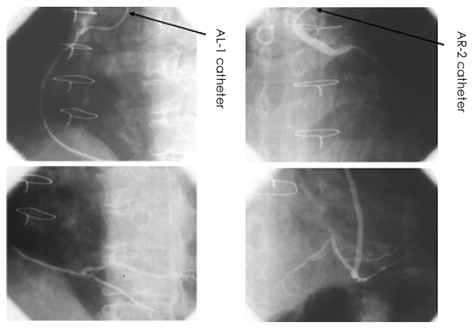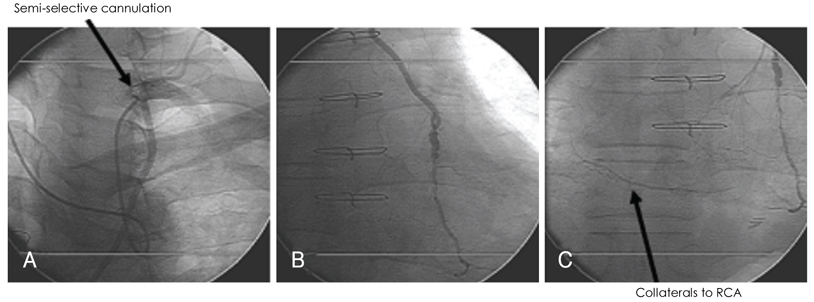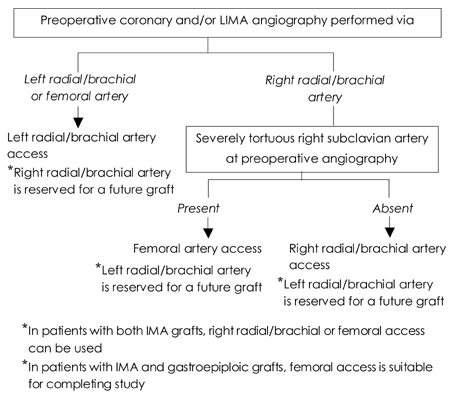Korean Circ J.
2009 Aug;39(8):304-309. 10.4070/kcj.2009.39.8.304.
The Feasibility of Bypass Graft Angiography by Right Radial Access
- Affiliations
-
- 1Cardiology Division, Department of Internal Medicine, Dong-A University College of Medicine, Busan, Korea. chaks@dau.ac.kr
- KMID: 2225679
- DOI: http://doi.org/10.4070/kcj.2009.39.8.304
Abstract
- BACKGROUND AND OBJECTIVES
Left transradial coronary angiography may result in damage of both radial arteries in patients who experienced right radial access. In some patients, the left radial artery has been used as a graft. We investigated whether graft angiography using right radial access is feasible in patients with bypass surgery to preserve the left radial artery as a future graft. SUBJECTS AND METHODS: A total of 109 consecutive patients with bypass surgery who had undergone right radial access underwent graft angiography via the same access. RESULTS: Sixteen (15%) patients were excluded because of the presence of a severely tortuous right subclavian artery. Bypass graft angiography via right radial or brachial access was completed successfully in 90 (97%) out of 93 patients. In 3 (3%) of patients, femoral access was needed to complete the angiography. Saphenous vein grafts were cannulated selectively in 150 (90%) of 167 grafts with satisfactory image quality and not found even on the aortogram in the other 17 (10%) grafts. Ninety-two (89%) out of 103 left mammary grafts were cannulated selectively or semi-selectively using a modified Simmons catheter, resulting in satisfactory image quality. The other 11 (11%) grafts were visualized non-selectively using a Judkins Left catheter, and resulting in acceptable image quality in 10 (91%) grafts. There were no procedure-related complications. CONCLUSION: Graft angiography via right radial access can be performed reliably in most patients that lack severe subclavian tortuosity.
MeSH Terms
Figure
Reference
-
1. Cooper CJ, El-Shiekh RA, Cohen DJ, et al. Effect of transradial access on quality of life and cost of cardiac catheterization: a randomized comparison. Am Heart J. 1999. 138:430–436.2. Louvard Y, Lefevre T, Allain A, Morice M. Coronary angiography through the radial or the femoral approach: the CARAFE study. Catheter Cardiovasc Interv. 2001. 52:181–187.3. Kiemeneij F, Laarman GJ, Odekerken D, Slagboom T, van der Wieken R. A randomized comparison of percutaneous transluminal coronary angioplasty by the radial, brachial and femoral approaches: the access study. J Am Coll Cardiol. 1997. 29:1269–1275.4. Yoon J, Lee SH, Kim JY, et al. The experience of trans-radial coronary intervention in Wonju. Korean Circ J. 1998. 28:1443–1451.5. Kim MH, Cha KS, Kim JS. Transradial interventions in coronary artery disease: comparison with transfemoral interventions. Korean Circ J. 1998. 28:1941–1952.6. Kim PH, Gwon HC, Kim YH, et al. The safety and feasibility in trans-radial coronary interventions for chronic total occlusion. Korean Circ J. 2004. 34:767–774.7. Park SJ, Park JH, Lee JH, et al. The clinical feasibility of transradial primary percutaneous coronary intervention with an ST elevation acute myocardial infarction. Korean Circ J. 2007. 37:72–77.8. Cha KS, Kim MH, Kim YD, Kim JS. Combined right transradial coronary angiography and selective carotid angiography: safety and feasibility in unselected patients. Catheter Cardiovasc Interv. 2001. 53:380–385.9. Yoo BS, Lee SH, Kim JY, et al. A case of transradial carotid stenting in a patient with total occlusion of distal abdominal aorta. Catheter Cardiovasc Interv. 2002. 56:243–245.10. Iwasaki S, Yokoyama K, Takayama K, et al. The transradial approach for selective carotid and vertebral angiography. Acta Radiol. 2002. 43:549–555.11. Fessler RD, Wakhloo AK, Lanzino G, Guterman LR, Hopkins LN. Transradial approach for vertebral artery stenting: technical case report. Neurosurgery. 2000. 46:1524–1527.12. Matsumoto Y, Hongo K, Toriyama T, Nagashima H, Kobayashi S. Transradial approach for diagnostic selective cerebral angiography: results of a consecutive series of 166 cases. AJNR Am J Neuroradiol. 2001. 22:704–708.13. Levy EI, Boulos AS, Fessler RD, et al. Transradial cerebral angiography: an alternative route. Neurosurgery. 2002. 51:335–340.14. Cowling MG, Buckenham TM, Belli AM. The role of transradial diagnostic angiography. Cardiovasc Intervent Radiol. 1997. 20:103–106.15. Galli M, Tarantino F, Mameli S, et al. Tranradial approach for renal percutaneous transluminal angioplasty and stenting: a feasibility pilot study. J Invasive Cardiol. 2002. 14:386–390.16. Wu CJ, Lo PH, Chang KC, Fu M, Lau KW, Hung JS. Transradial coronary angiography and angioplasty in Chinese patients. Cathet Cardiovasc Diagn. 1997. 40:159–163.17. Louvard Y, Krol M, Pezzano M, et al. Feasibility of routine transradial coronary angiography: a single operator's experience. J Invasive Cardiol. 1999. 11:543–548.18. Mann T, Raza JA, Whitlock CH, Arrowood M. Transradial management of saphenous vein bypass graft disease using rheolytic thrombectomy and coronary stenting. J Invasive Cardiol. 2003. 15:221–223.19. Saito S. Right or left side? Catheter Cardiovasc Interv. 2003. 58:305.20. Cha KS, Kim MH, Kim HJ. Prevalence and clinical predictors of severe tortuosity of right subclavian artery in patients undergoing transradial coronary angiography. Am J Cardiol. 2003. 92:1220–1222.21. Cha KS, Kim MH, Hung JS, Woo JS, Kim YD, Kim JS. Nonselective left internal mammary artery angiography during right transradial coronary angiography: a simple, rapid and safe technique. Angiology. 2001. 52:773–779.22. Cha KS, Kim MH. Feasibility and safety of concomitant left internal mammary arteriography at the setting of the right transradial coronary angiography. Catheter Cardiovasc Interv. 2002. 56:188–195.23. Bhatt SN, Jorgensen MB, Aharonian VJ, Mahrer PR. Nonselective angiography of the internal mammary artery: a fast, reliable, and safe technique. Cathet Cardiovasc Diagn. 1995. 36:194–198.24. Kuntz RE, Baim DS. Internal mammary angiography: a review of technical issues and newer methods. Cathet Cardiovasc Diagn. 1990. 20:10–16.25. Louvard Y. Marco J, Fajadet J, Henry M, Amor M, editors. Graft angiography via the right transradial approach. Endovascular Therapy Course Coronary And Peripheral: Ninth Complex Coronary Angioplasty Course Book. 1998. Paris: Europa;325–327.26. Sharma GL, Louvard Y, Tavolaro O, et al. Less invasive PTCA of a gastroepiploic artery combining the transradial approach and 5 Fr guiding catheter: a case report. Catheter Cardiovasc Interv. 2002. 56:494–497.27. Caputo RP, Simons A, Giambartolomei A, et al. Safety and efficacy of repeat transradial access for cardiac catheterization procedures. Catheter Cardiovasc Interv. 2001. 54:188–190.28. Yoo BS, Lee SH, Ko JY, et al. Procedural outcomes of repeated transradial coronary procedure. Catheter Cardiovasc Interv. 2003. 58:301–304.29. Wakeyama T, Ogawa H, Iida H, et al. Intima-media thickening of the radial artery after transradial intervention: an intravascular ultrasound study. J Am Coll Cardiol. 2003. 41:1109–1114.
- Full Text Links
- Actions
-
Cited
- CITED
-
- Close
- Share
- Similar articles
-
- Analysis of Suitability of Radial Artery Graft as Bypass Conduit after Transradial Catheterization
- Harvesting of Radial Artery With Harmonic Scalpel
- Determination of Early Graft Patency Using CT Angiography after Coronary Artery Bypass Surgery
- Feasibility and Problems in Transradial Coronary Angiography and Intervention
- A Rare Case of Radial Arteriovenous Fistula After Coronary Angiography






